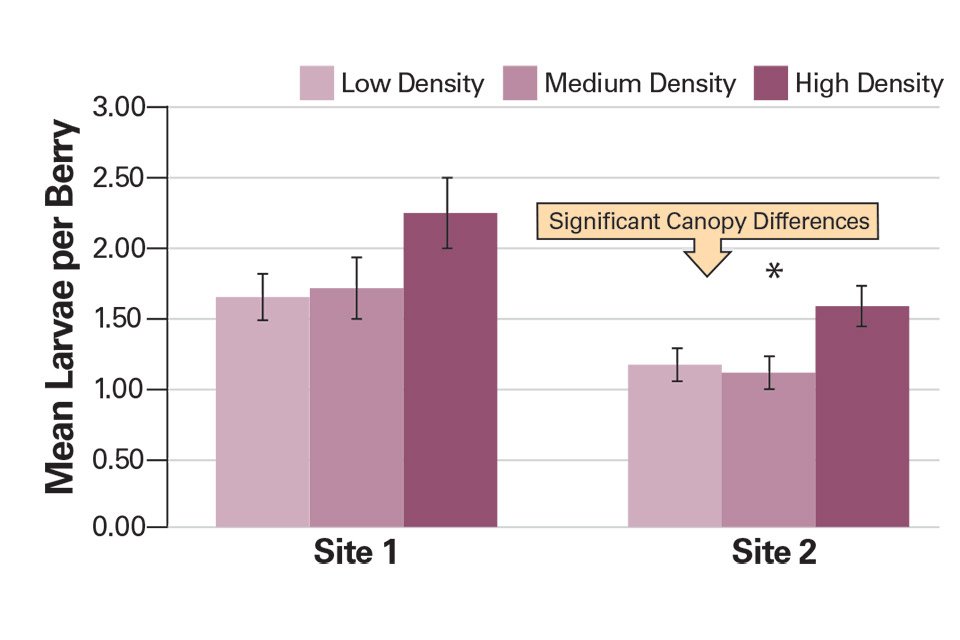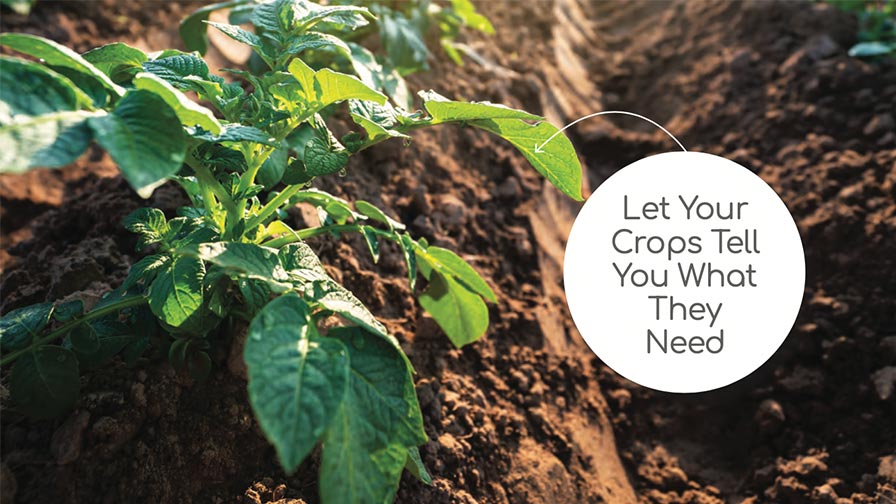Does Canopy Climate Impact Spotted Wing Drosophila Pressure?

University of Maryland undergraduate student technicians Logan Miller and Alyssa Truong measure raspberry canopy as part of a national project studying cultural control tactics for SWD. (Photo: Photo: Kelly Hamby)
When it comes to spotted wing drosophila (SWD), you’ve heard the same story since 2013 (2008 if you’re a grower in California).
It goes something like this: Early in the season, you hear that SWD pressure varies year to year based on climate. By season’s end, populations are consistently high, and harvests are in jeopardy.
“When SWD first invaded, growers and researchers scrambled to find quick solutions, which necessitated using insecticides,” says Kelly Hamby, Assistant Professor of Entomology at the University of Maryland. “We cannot rely solely on insecticides to manage insect pests. Insects frequently develop resistance to insecticides, and relying so heavily upon them increases the likelihood of resistance developing.”
Insecticides are known to disrupt the production cycle and reduce the population of beneficials necessary to our industry.
“Outbreaks of pests that historically were not problematic have occurred in response to SWD management,” she says. “A more integrated approach that uses multiple tactics to keep SWD below an economically damaging level will improve pest management. Therefore, growers and researchers are working to better understand SWD’s biology, develop novel management tactics, and build an integrated pest management program that better manages SWD.”
Enemy No. 1
According to Ash Sial, Assistant Professor of Entomology at the University of Georgia, SWD is the No. 1 concern for small and stone fruit growers in his region.
“If growers are unable to treat SWD, there will be no harvest,” he says. “Growers will be unable to pack and sell the fruit and there could be 100% crop loss.”
“The frustrations and expense of dealing with SWD are impacting profitability and production decisions,” Hamby says. “Some growers have stopped growing SWD-susceptible crops. This could reduce consumer access to these nutritious fruit crops.”
A lot is at stake; the industry is working hard to find a solution. Their work started in a laboratory before extending into the field.
“In the laboratory, SWD begin to exhibit symptoms of heat stress at 87.6°F, as well as survive and reproduce better at higher humidity,” Hamby says. “In the field, SWD seem to prefer the center and lower parts of the crop canopy, presumably because it is cooler and more humid. For this reason, we investigated whether pruning could be used to make the canopy climate less suitable for SWD in blueberries and raspberries. We expected that by pruning out plant material and opening the canopy we would increase light penetration, resulting in potentially hotter and drier conditions.”
Hamby and Sial, Project Director, teamed with Rufus Isaacs and Matt Grieshop (Michigan State University), Mary Rogers (University of Minnesota), Vaughn Walton (Oregon State University), Hannah Burrack (North Carolina State University), Frank Zalom (University of California), Christelle Guedot (University of Wisconsin), Oscar Liburd (University of Florida), Donn Johnson and Jennie Popp (University of Arkansas), and Tracy Leskey and Jana Lee (USDA-ARS) to test their theory.

At the University of Maryland, the average number of SWD larvae per berry was compared between different canopy pruning treatments of low-, medium-, and high-canopy density in otherwise untreated plants. The results are shown here. (Graphic: Kelly Hamby)
Project Goals
The project began in the fall of 2015 and is expected to conclude later this year and is supported by the Organic Agriculture Research and Extension Initiative (OREI), the USDA’s National Institute of Food and Agriculture. The goal, according to Sial, is to create an SWD pest management program that “focuses on behavioral and cultural controls so organic growers can use fewer chemicals to effectively control the pest.”
“We designed these studies as proof-of-concept to see whether we could change the canopy and canopy climate enough to impact SWD,” Hamby says. “We compared three levels of pruning that resulted in high, medium, and low-density canopies.”
Hamby and her team did not see enough SWD pest pressure in blueberries to compare the treatments but had more success at one of their raspberry test sites.
“We observed cooler temperatures and higher SWD infestation in high-density treatments at this site,” she says. “Because our pruning treatments reduced the fruit-bearing portions of the plant, the high-density treatments also produced more total yield. As seen in previous studies, SWD infestation was also higher in the center of the canopy.”
Similar results were observed at the University of Georgia where heavily pruned canopies allowed in more light, lowered humidity, and increased temperature.
“These conditions are less hospitable for SWD and resulted in poorer SWD survival and lower SWD infestation,” Sial says. “While heavy pruning may reduce overall yield in some growing regions, it has other horticultural benefits. For instance, in one of our studies heavier pruning resulted in larger berries that ripened earlier in the season. Additionally, the reduced canopy can improve spray coverage and therefore the efficacy of spray applications to control SWD and other pests and diseases.”
Sial and his team also analyzed various mulching techniques and their impact on SWD.
“SWD larvae often emerge from fruit to pupate in a suitable, protected place,” he says. “Some pupating larvae drop to the ground to pupate below the soil surface. Our studies suggest that using black plastic weed mat as a mulch on the ground provides an effective barrier that prevents larvae from pupating underneath the soil surface, reducing SWD survival.”
Promising Findings
According to the study, you may be able to lower the chances of SWD infestation in your fruit if you plan to prune and mulch accordingly. The research team is in the final stages of the project and working to develop organic strategies for SWD control.
“Our study suggests that canopy climate impacts SWD infestation and that managing the canopy can change canopy climate,” Hamby says. “We and other researchers are now working on canopy management techniques that reduce favorability for SWD while maintaining fruit yield. We’re also working to integrate this approach with other tactics to develop an effective integrated pest management program for SWD.”
“Because this problem is a long-term problem, we are hoping to get more funding to work to develop more pest-management strategies down the road,” Sial says.
Any opinions, findings, conclusions, or recommendations expressed in this publication are those of the researchers and do not necessarily reflect the view of the U.S. Department of Agriculture.










